Meet the Plants! SF Botanical Garden Looks Like Willy Wonka’s Chocolate Factory for Flora
Description
Stepping onto the 55-acre grounds of the San Francisco Botanical Garden feels a bit like entering the chocolate room at Willy Wonka’s factory, if that storybook setting were bursting with real plants instead of ones made of candy.
Located in the heart of Golden Gate Park, just blocks away from bustling city life (though not as bustling during these days of the pandemic), the garden is home to an astounding array of more than 9,000 types of flowers, plants and trees from across the globe. When not subject to various levels of quarantine, roughly 400,000 visitors a year tour the grounds, which are open seven days a week and are free to city residents. Horticulturist John McLaren, the Golden Gate Park superintendent for over 50 years, first devised plans for the garden in the late 1800s. But funding problems prevented an official opening until 1940.
<figure id="attachment_1967325" class="wp-caption alignright" style="max-width: 800px">
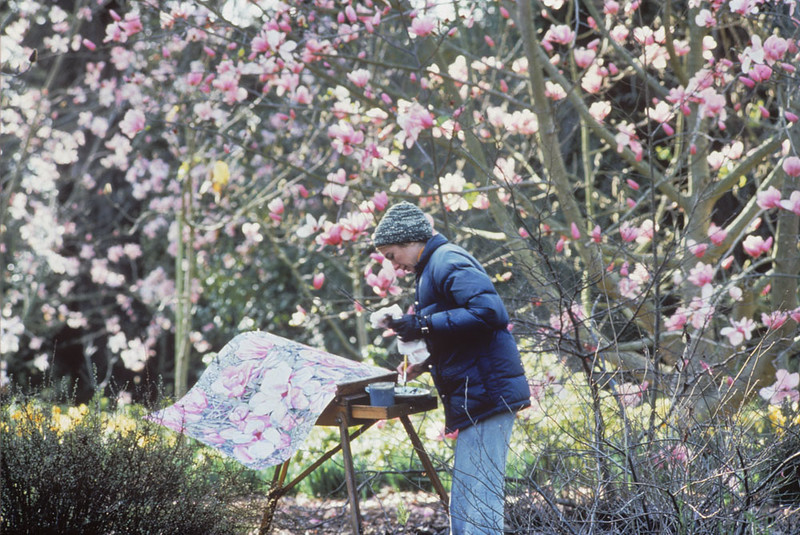 <figcaption class="wp-caption-text">Artist Patricia Forrester painting magnolias in the garden in 1978. (Courtesy of the SF Botanical Garden)</figcaption></figure>
<figcaption class="wp-caption-text">Artist Patricia Forrester painting magnolias in the garden in 1978. (Courtesy of the SF Botanical Garden)</figcaption></figure>Here they can take in velvety pink and magenta flowering magnolias from the Himalayas; endangered South African proteas that grow on a single mountain; and something called a monkey puzzle tree, a rare evergreen from Chile with limbs of sharp, succulent-like leaves unfolding from its trunk. As for native species, the garden hosts everything from California lilac to giant sequoias.
In this 150th year of Golden Gate Park and 80th of the Botanical Garden, the garden has unveiled plans for a brand new nursery to advance its mission of preserving endangered plants increasingly threatened by climate change.
From Big Beach to Big Garden
Staring out at the sanctuary’s lush lawns and winding forested foot trails, it’s hard to imagine this was all once nothing but sand dunes.
Before Golden Gate Park was established in 1870, the dunes stretched out over its thousand-acres, extending east from Ocean Beach, where San Francisco meets the Pacific at the edge of the continent.
<figure id="attachment_1967328" class="wp-caption alignnone" style="max-width: 800px">
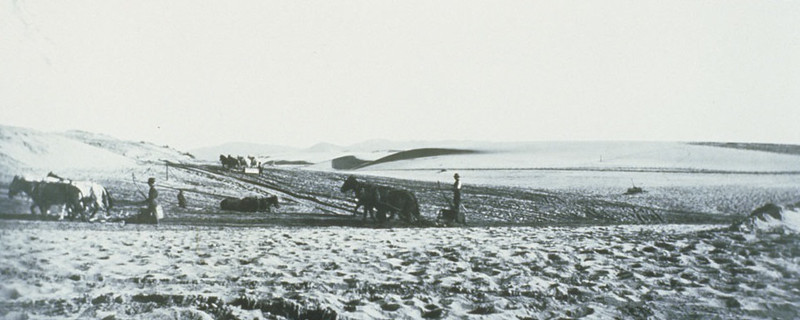 <figcaption class="wp-caption-text">Golden Gate Park, as pictured in the late 1800s, was once sand dunes stretching east from Ocean Beach. (Courtesy of SF Botanical Garden)</figcaption></figure>
<figcaption class="wp-caption-text">Golden Gate Park, as pictured in the late 1800s, was once sand dunes stretching east from Ocean Beach. (Courtesy of SF Botanical Garden)</figcaption></figure>“This was just a big dune all the way out. If you dig down 2 feet anywhere here, it’s gonna be sand,” said garden docent Kyle Pierce, while leading a tour in late February, just weeks before the pandemic shut the garden down for several months. It reopened in June, with safety protocols requiring masks and a capacity limit of 2,500 people.
To transform the terrain from beach to garden, he says, the city plowed in horse manure and nutrient-rich soil, so plants could take root and thrive.
<figure id="attachment_1967327" class="wp-caption alignright" style="max-width: 800px">
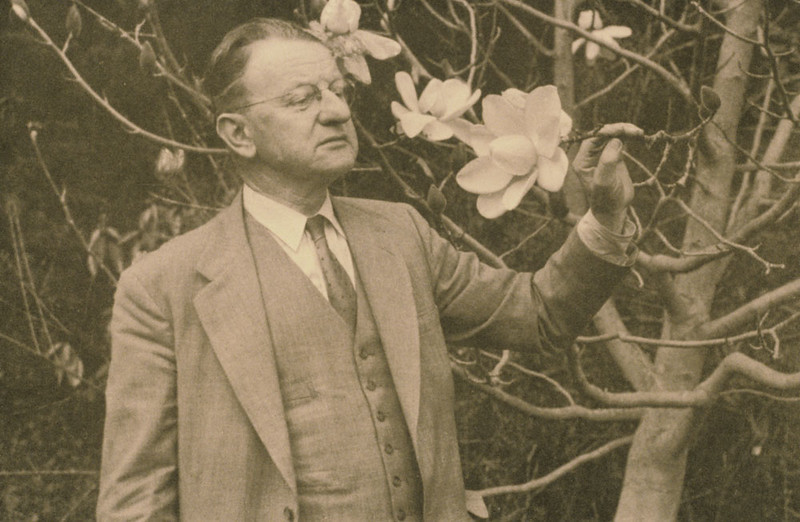 <figcaption class="wp-caption-text">Eric Walther, the garden’s first director, pictured next to a blooming Magnolia campbellii, his favorite plant, in the 1940s. (Courtesy of the SF Botanical Garden)</figcaption></figure>
<figcaption class="wp-caption-text">Eric Walther, the garden’s first director, pictured next to a blooming Magnolia campbellii, his favorite plant, in the 1940s. (Courtesy of the SF Botanical Garden)</figcaption></figure>“If you amend it enough, you can grow anything,” he said. “By 1879 they’d already planted 150,000 trees.”
Many of the initial Monterey cypress, Monterey pine and blue gum eucalyptus trees remain in the park today, 150 years later. The species were chosen, Pierce says, to serve as a windbreak for other plants to grow.
Preserving Flora From Across the Globe
Over time, the garden has become a refuge for threatened plants from all over the world. One of its main attractions is a collection of more than a hundred different types of magnolia trees, which bloom for three months at the start of each year.
These trees have been dubbed the most significant collection of magnolias for the purposes of conservation outside of China by Botanic Garden Conservation International, a global plant preservation society.
<figure id="attachment_1967300" class="wp-caption alignright" style="max-width: 800px">
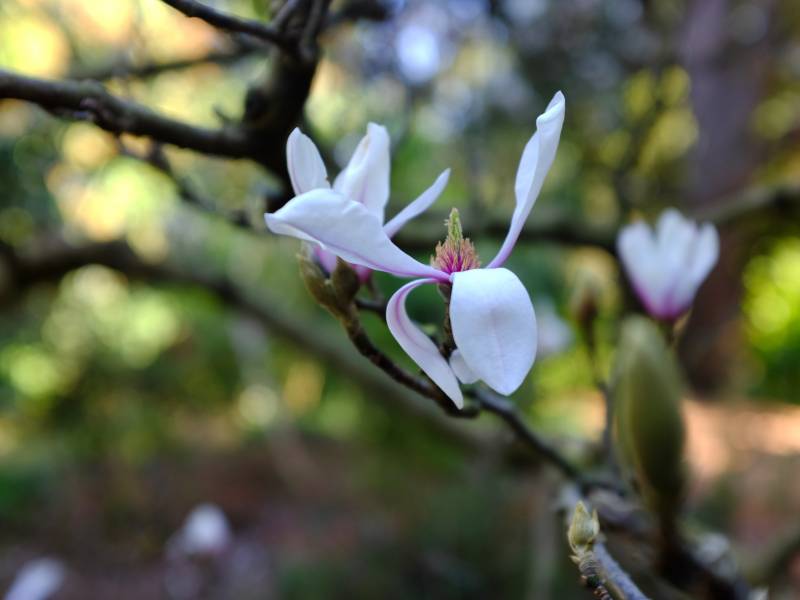 <figcaption class="wp-caption-text">A zen magnolia blossoming at the San Francisco Botanical Garden in February 2020. Less than 20 of these trees are left in the wild. (Peter Arcuni/KQED)</figcaption></figure>
<figcaption class="wp-caption-text">A zen magnolia blossoming at the San Francisco Botanical Garden in February 2020. Less than 20 of these trees are left in the wild. (Peter Arcuni/KQED)</figcaption></figure>On our walk, Pierce points out the distinct cup-and-saucer arrangement of one magnolia’s pink-hued petals. This Magnolia campbellii, a native to Himalayan valleys, became the first of its kind to blossom in the U.S. back when the garden opened in the winter of 1940.
The rarest tree of the bunch is the Magnolia zenii, or the zen magnolia. Its flowers, snowy white with purple stripes, are smaller and more delicate than the others we passed.
“Only 18 individuals exist in the wild within one province in China, with no sign of regeneration,” Pierce said. “A lot of the garden’s magnolias are wild-collected. So they’re preserving a DNA of wild species.”
The San Francisco Botanical Garden and other created havens for flora play a critical role in protecting plants that are at risk of extinction due to climate change and deforestation.
“Botanical gardens, public gardens, are a key mechanism in making sure those plants don’t disappear from humanity,” said the San Francisco garden’s director, Matthew Stephens. “Because what the research suggests is that they probably won’t be wherever they’re growing now in 150 or 200 years.”
<figure id="attachment_1967324" class="wp-caption alignright" style="max-width: 800px">
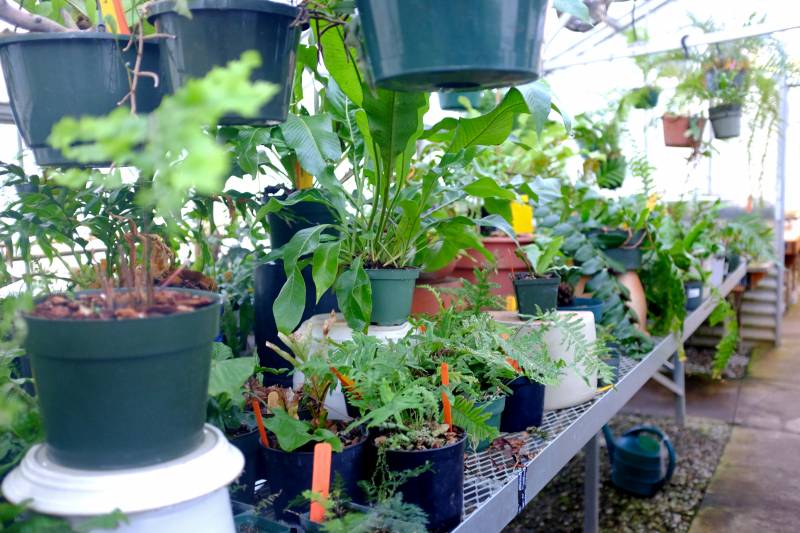 <figcaption class="wp-caption-text">In the greenhouse, horticulturists raise plants from seeds or seedlings until they’re ready to move to the garden outside. (Peter Arcuni/KQED)</figcaption></figure>
<figcaption class="wp-caption-text">In the greenhouse, horticulturists raise plants from seeds or seedlings until they’re ready to move to the garden outside. (Peter Arcuni/KQED)</figcaption></figure>To protect threatened species, he says, the garden partners with greenhouses, nonprofits and governmen






